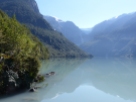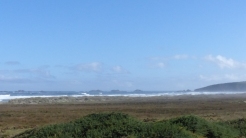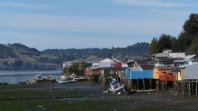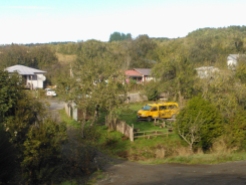On our route north to Santiago we a zig-zaged, to and fro across the Andes, between Argentina and Chile. The Argentinian sections are in the accompanying blog here. Our Chilean journey started with the wild Carretera Austral in far south. We then detoured back east into Argentina, before a final leg back in Chile from the largest island in South America, passing (and narrowly missing) active volcanoes all the way up to Santiago.
Bruce here…
1: The wild south
The Carretera Austral (Chilean “Ruta 7”, 1,240km long) goes all the way from Villa O’Higgins in the far south, just north of Los Glacieres national park, to Puerto Montt. The road was constructed in the Pinochet era to connect the south to the rest of Chile. It is mostly “ripio” (gravelled) but much of it is currently being paved, which certainly makes the driving a lot easier but some would argue less interesting. It may start at Villa O’Higgins but arriving from the south, Villa O’Higgins can only be approached by small ferries taking foot (or bicycle) passengers.
For those overlanders driving north, the first place you can pick up the Carretera Austral is coming from the border crossing at Los Antiguos (the cherry mecca of Argentina) to Chile Chico and this is indeed where we returned to Chile. The route winds around lakes and fjords, through beautiful scenery and greater diversity of fauna and flora as you go north. The driving on the “ripio” roads can be quite slow and being to the west of the Andes, rain was something we began to encounter more regularly. The road is interspersed with small villages and towns, where most of the population live. Indeed one town, Villa Cerro Castillo, was only really established in the 1960s when the locals got together to build a school so that they wouldn’t have to send their children away anymore, with the town becoming established around the school. This orginal school has recently been renovated and is now an interesting little museum that also includes access to the local “Cave of Hands”. This one is on a much smaller scale than the UNESCO site in Argentina but, without fences, you can get right up close to the paintings.
The Carretera Austral may travel through a very remote part of Chile, with few vehicles driving up and down, it but it is actually one of the most popular cycling routes in the world. It is also popular with Chilean students in the summer, who hitch-hike the length of it. We coincided with the end of the summer holidays and there seemed to be more hitch-hikers than potential lifts! This means that they have to be very patient, have some reserves of food with them and be prepared to camp the night by the road! Even though we don’t have any seats in the back, we did our bit in a small way giving a couple of lifts to those who were happy just to lounge in the back on the bed, extracting names of interesting Chilean music to listen to in return (as well as a share of mate, although it is not so widely drunk in Chile). A further highlight on the road was a meal (simple but extremely tasty) at the only restaurant open in Puyuhaupi, where we also had our first encounter with the thermal springs that are a feature of this side of the Andes.
The end of this section of the road for us was to be Chaiten, from where we could get a ferry to the island of Chiloe, before heading north. Realising that autumn was catching up with us and a deterioration in the weather might limit our opportunity to appreciate some (more) of the best trekking the southern Andes has to offer, which is on the Argentinian side, we cancelled our ferry ticket and backtracked to take a sharp right and head east again, back across the border into Argentina for about a month before coming back into Southern Chile to complete the journey north..
2: Volcanoes and rain
Whilst we had clearly seen our first major volcanoes from our trekking in Frey (Mount Tronador was the closest), the drive through the border to Chile should have been quite spectacular, taking us the closest yet to volcanoes. I’m sure it is as you drive through an area that has relatively recently seen an eruption, but when we were there, there was a lot of rain for a couple of days and little to see except cloud. This was fine for sitting in a thermal pool but not so good for views! Over time, we started to find a pattern to the weather, with a couple of days of cloud and rain broken up by glorious day to give us a glimpse of the spectacular views before the weather set in again. A bit like being on the west coast of the UK!
Putting the rather disturbing loud noise that had developed when we drove down to many, several large, holes in the exhaust, the first thing we did when we got into Chile was to get the exhaust patched up by a bit of welding to get us through the week we had planned on the island of Chiloe. This done, we boarded the ferry and went to the island. It was a last stronghold for the Mapuche, who held out against the Spanish conquistadors far longer than everywhere else. The island are known for having many different varieties of potatoes and a good variety of seafood, as well as for their churches built in a local style with tiles of wood, originally using the Alerce trees. On the island, there are three major towns and a large proportion of it is national park. The west coast is pounded by the Pacific Ocean, whilst from the east on a good day you can see a number of impressive volcanoes on the mainland amongst the Andes. It was a place that we hadn’t originally planned on visiting, but are very glad that we did.
On leaving Chiloe, we went to Puerto Montt to get our still noisy exhaust sorted out properly. This was achieved by most of the pipe (apart from the mufflers) being replaced and so we then set off north. However, the van was still making a huge racket when we drove over 50km/h, which was not a good sign seeing as we had over 1,000km to go to get to Santiago. We thought it might be a wheel bearing and so returned to our friendly exhaust mechanic, who in turn recommended another mechanic in Puerto Montt. It was indeed a worn wheel bearing and thankfully no further damage had been done, despite our driving on it thinking the noise was exhaust, for some time. During the couple of unexpected days in the town, which doesn’t have a lot to offer the tourist, we focused on food and drink experiences, finding a café dedicated to Sherlock Holmes (which Becca enjoyed), and a rugby themed bar that had a corner devoted to the local climbing club (which ticked my boxes)! We also took the opportunity to further enjoy the sea food.
Once the van had been sorted out, we then moved on, albeit with a few days fewer than we had intended for the rest of our journey to Santiago. Stopping in Puerto Varras for lunch (and to try and see views of Volcáns Osorno and Calbuco), we couldn’t have known that, just a few days later, Volcán Calbuco would erupt spectacularly. Our drive north included a night at Villarrica, where we had breakfast at the foot of the volcano which had experienced a small eruption a few weeks earlier, and a couple of days in Parque Nacional Congruillo, with amazing forests of monkey puzzle trees around Volcán Llaima, which last erupted in 2009.
By now, our deadline to get to Santiago and receive equipment being sent out from Oxford for our field trip to Robinson Crusoe island was approaching, so hit the “Ruta 5” and headed north…
A gallery of more pictures from our exploration of southern Chile:











































































































Pingback: The winding road to Santiago – part 1: Argentinian delights | Yellow Van Days
Keep the news updates coming as we’ll be on a similar journey ourselves early next year provided the wheels don’t fall off! Almost sorted the vehicle out and now down to two choices which we’ll nail at the overland expo in Germany end August. Planning is the easy part deciding on which vehicle has been harder than we’d imagined. How is the T4 performing as we’ll probably end up with a T5 poop-up? Regards to you both from London England (not Ontario)!
LikeLike
Be careful with a T5 with DPF – you won’t be able to go into the high Andes (over 3500 metres), because at such altitudes the particle filter will clog up! Expensive to repair…
LikeLike
Hi guys, glad to hear your plans are progressing well, but, as Juergen says, be careful to consider the effect of altitude on your vehicle. European ones just aren’t built altitude ready… Perhaps it’s a good argument for buying locally… We have met a retired German couple out here in a new T5 and they have come to the decision that they will leave their van in Argentina or Chile and hire a local car to go into Bolivia because VW have told them they can’t be sure what will happen when they go higher than 3,000m. It’s the electronics and programming related to the particulate filter they are most concerned about, but they were not sure more generally about how the electronics would respond when they go outside of normal parameters. One of the reasons we got such an old vehicle was because it means the electronics are pretty basic and, even if things aren’t functioning fully optimally, we can just ignore it and still drive. Modern vehicles switch themselves into some sort of “limp mode” if they don’t like what’s going on – or so we have heard. And, for good or bad, we don’t even have a particulate filter! Would have been nice if our old van had had a little lower mileage, but then we weren’t in a position to be too picky at that time!! Good luck – I’m sure the guys at Overland Expo will sort you out!
LikeLike